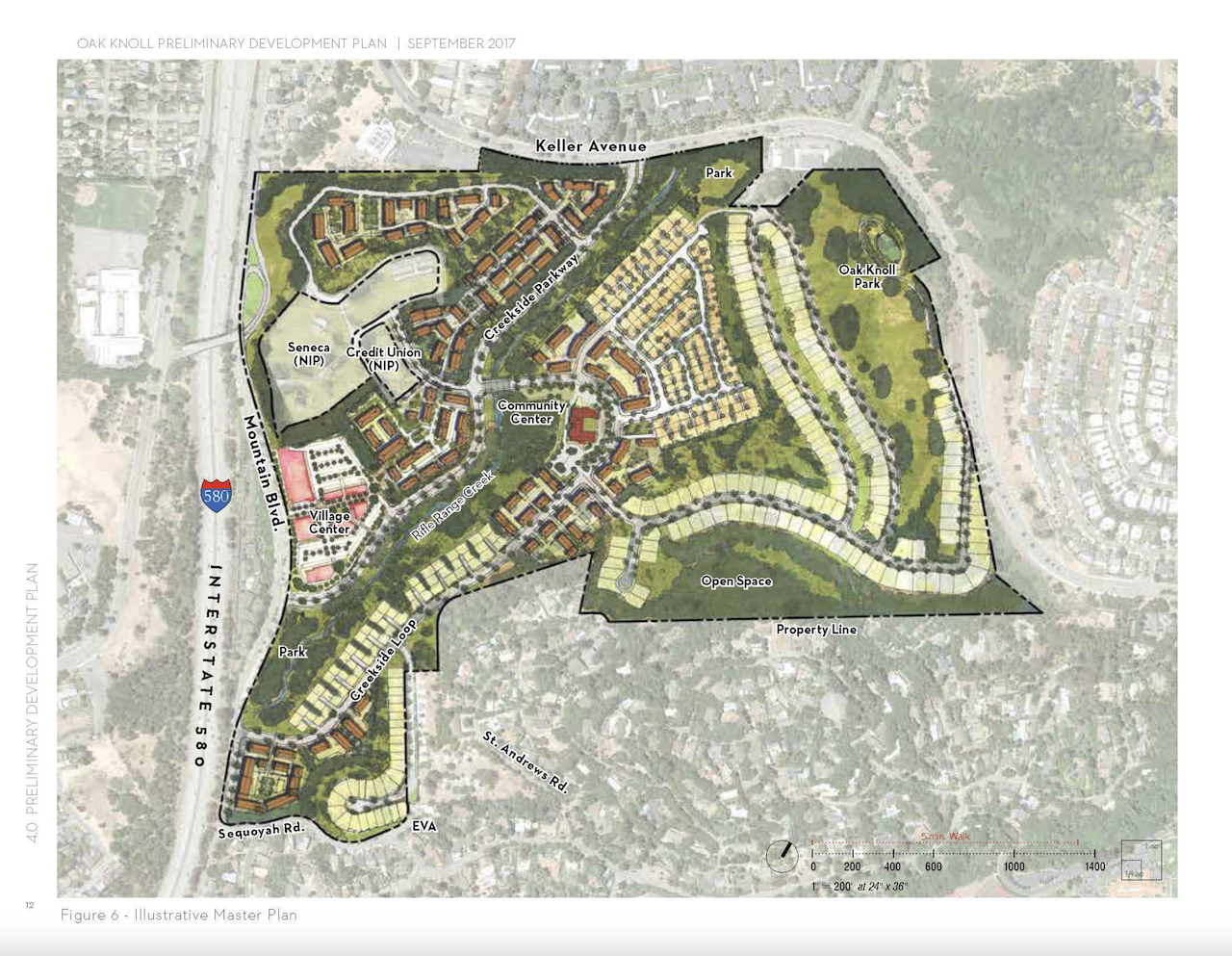Capital
Private Capital Strikes Again: Oak Knoll’s $130M Kickstart
A historic Bay Area naval site is being transformed into a master-planned community amid the toughest credit market in years. With banks pumping the brakes, private capital is fueling a critical project in San Francisco's housing crisis.

Private capital has shifted into an ever-more-critical supporting role, shaping the present and future of U.S. homebuilding and residential development.
As regional banks continue to hibernate from their typical levels of dominance and hold acquisition, development, and construction (AD&C) lending in check, private capital firms like Avila Real Estate Capital have stepped in to bridge the financing gap for developers and homebuilders.
The recapitalization of the Oak Knoll Naval Hospital site in Oakland, California— a $130 million transaction facilitated by Avila Real Estate Capital — is a real-world case study of how these firms give especially meaningful housing projects a lifeline in a capital-constrained environment.
Oak Knoll: A Historic Site With New Purpose
The Oak Knoll site carries deep historical significance. Built in 1942 as a U.S. naval hospital for World War II veterans, it later served service members from the Korean and Vietnam Wars before closing in 1993. For more than three decades, the 183-acre site has remained largely undeveloped, a striking example of the Bay Area’s struggle to deliver new housing amid financial, regulatory, and political hurdles.
Previous redevelopment efforts stalled due to capital constraints and shifting priorities. In the mid-2000s, SunCal Development purchased the site with ambitious plans, but the project languished. Now, under Freehold’s management and with Avila Real Estate Capital orchestrating a critical recapitalization, Oak Knoll is poised to become one of the largest residential developments in the Bay Area in a decade. Here's one view of the community's impact:
The Oak Knoll Mixed-Use Community in Oakland represents a bold vision for sustainable living. Spanning 191 acres, this master-planned development at the former Oak Knoll Naval Medical Center is a blend of residential, commercial, civic, and open spaces. With a focus on sustainability, historical preservation, and community amenities, Oak Knoll is poised to redefine urban living in Oakland."

Once completed, the Oak Knoll master-planned community will deliver more than 900 homes, 80,000 square feet of retail space, and 84 acres of public parks, trails, and open space. The project also includes the restoration of a long-buried creek and the relocation of the historic Club Knoll, repurposed as a community and retail hub.
This project represents the kind of large-scale, thoughtful development the Bay Area desperately needs,” said Tony Avila, CEO of Avila Real Estate Capital. “By recapitalizing Oak Knoll, we’re not just advancing a major residential project — we’re reinforcing the essential role private capital plays in sustaining housing supply.”
A New Financing Model for Homebuilding’s Future
The Oak Knoll recapitalization illustrates a broader shift in residential real estate financing. With over $900 million in land acquisition and development loans outstanding, Avila Real Estate Capital has positioned itself as a pivotal player in funding residential projects that might otherwise stall due to a lack of access to capital.
This is about more than just a single transaction,” Avila explained. “We’re creating an integrated ecosystem that spans investment banking, capital raising, land acquisition, and development. We own and develop land, we sell lots to builders, and we provide the financing needed to bring these projects to life. This allows us to offer a one-stop-shop solution that simplifies what is traditionally a highly fragmented financing process.”
The firm’s merger with Pacific InterWest, a third-party construction inspection services company, further enhances its integrated capabilities. The merger brings technical expertise in quality assurance, code compliance, and construction progress monitoring — critical elements in ensuring project viability in a high-cost, high-regulation market like California.
PIW has solidified its position as a powerhouse of the construction industry. PIW's comprehensive suite of services spans the entire residential construction lifecycle. PIW is a leader in risk mitigation services, including peer plan reviews, course of construction inspections, SB-721 and SB-326 balcony/deck inspections, HERS testing, Title 24 services, water testing, and full-service commercial drone data collection."
Why Private Capital Is More Important Than Ever
The Oak Knoll recapitalization comes at a time when access to AD&C loans from traditional banks is at a historic low. Several macroeconomic forces have contributed to this pullback:
- Regional Bank Failures: The collapses of multiple U.S. regional banks in early 2023 triggered a deposit flight to larger institutions, reducing lending capacity for small and mid-sized developers.
- Rising Debt Maturities: More than $2 trillion in commercial real estate loans are set to mature between 2024 and 2027, leading to refinancing difficulties and tighter credit availability.
- Higher Interest Rates: Elevated borrowing costs have made it harder for developers to secure capital through conventional means.
- Regulatory Constraints: Increased regulatory scrutiny and risk aversion among banks have further restricted lending activity.
According to Avila,
The volume of AD&C loans has declined from a post-Great Recession high of $105 billion in Q1 2023 to $95 billion in Q1 2024. That $10 billion contraction in lending availability has a direct impact on builders’ ability to bring new supply to market.”
Further exacerbating challenges, the National Association of Home Builders (NAHB) recently reported that AD&C financing continues to tighten, with loan-to-value ratios shrinking and banks reducing overall lending amounts. Additionally, rising material costs remain a persistent issue. The NAHB’s latest data shows that construction input prices increased by 1.2% in January alone, with costs for critical materials such as concrete, millwork, and sheet metal products continuing to rise. These pressures disproportionately impact smaller, privately capitalized homebuilders, who often lack the financial flexibility of larger public firms.
2025: A Litmus Test for Smaller Builders and Developers
As the industry moves into 2025, smaller and mid-sized homebuilders face an existential challenge: how to secure the land and lot pipeline necessary to sustain their businesses in a tightened credit market. Without access to capital, many will struggle to keep their operations running, further consolidating market power in the hands of larger public builders and well-capitalized private firms.
Avila Real Estate Capital’s role extends beyond financing individual deals. It actively powers the market by providing alternative pathways for builders and developers to continue growing. The firm’s upcoming invitation-only forum, featuring 75 of the top builders and six of the largest developers, is designed to foster collaboration and strategic partnerships that address these ongoing challenges.
Keeping the market powered-up
The recapitalization of Oak Knoll is emblematic of the new reality in housing finance. As traditional credit sources keep their spigots set to a trickle, private capital is stepping in to ensure critical housing projects proceed. Avila Real Estate Capital’s growing influence across land development, construction inspection, and capital financing reflects a fundamental shift in how residential real estate projects are funded, executed, and, ultimately, become profitable.
In 2025, the stakes are higher than ever,” Avila concluded. “The housing market needs liquidity, it needs expertise, and it needs a financing structure that supports sustainable development. That’s what we’re building — an integrated platform that keeps the engine of housing supply running.”
For builders, developers, and investors navigating the challenges of a constrained credit environment, partnerships with firms like Avila Real Estate Capital may prove to be the key to unlocking continued growth and resilience in the years ahead.
MORE IN Capital
Steel, Skeptics, And The Real Innovators In U.S. Homebuilding
TBD MasterClass contributor Scott Finfer shares a brutally honest tale of land, failed dreams, and a new bet on steel-frame homes in Texas. It's not just bold — it might actually work.
Housing’s High-Stakes Year: Six New Home Market Shifts To Watch
A massive liquidity crunch is reshaping homebuilding’s financial landscape. M&A is accelerating as builders chase capital and growth.
JP Morgan’s Latest Power Move: A Homebuilding Shake-Up in the SFR Market
JP Morgan’s new venture with Paran Homes signals a shift in housing’s power structure. Institutional capital isn’t just funding BTR communities—it’s now shaping how they’re built. This could be a flashpoint for private homebuilders and developers navigating the M&A landscape.


